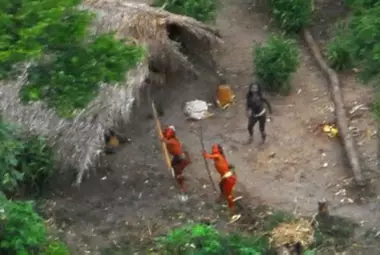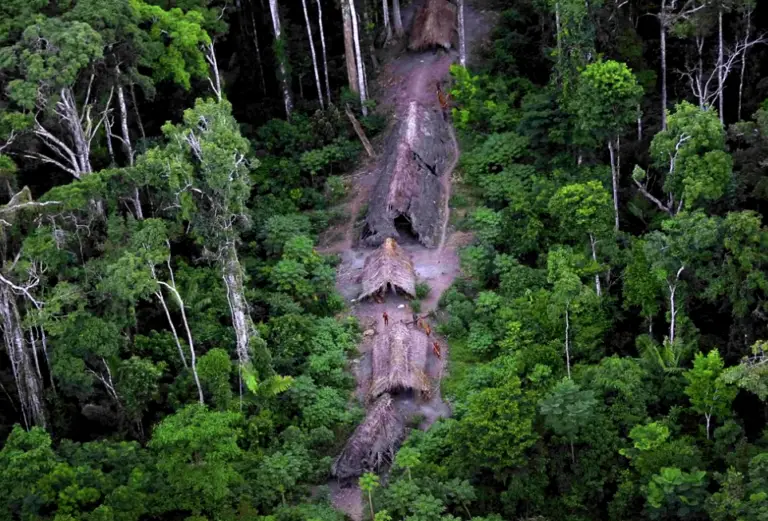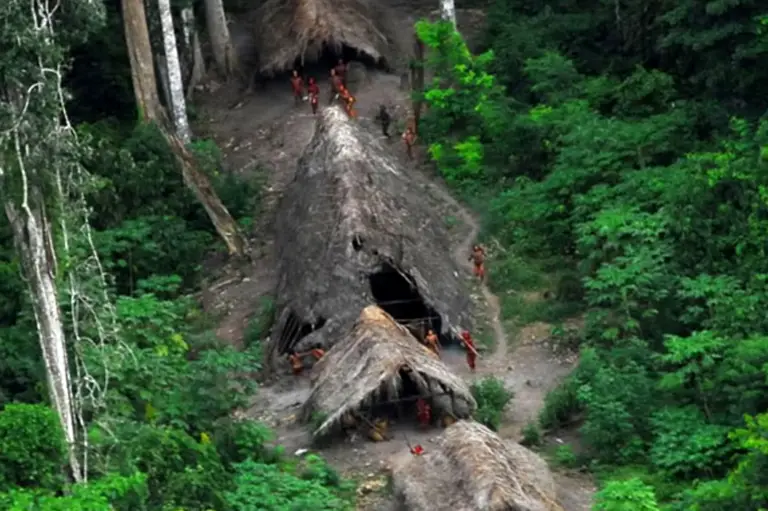G. Miranda’s captivating drone photography, commissioned by Survival International, offers a rare and remarkable window into the existence of uncontacted tribes across the globe. These stunning visuals provide a unique perspective, giving us a glimpse of tribes living in isolation, such as the enigmatic Sentinelese on North Sentinel Island in India and the diverse Amazonian communities residing along the Javari River valley on the Peru border. Miranda’s aerial shots not only pique our curiosity but also shed light on the lives and landscapes of these secluded societies, sparking intrigue and empathy. This extraordinary collection of images invites viewers to explore the world’s hidden cultures from above, allowing us to appreciate their resilience and adaptability in a rapidly changing world.

The captivating video compilation of these extraordinary photographs, posted on the Death Island Expeditions YouTube page in 2018, has garnered over 3.5 million views. The footage showcases small settlements and homes of these tribes, providing a rare glimpse into their daily lives.
The images captured by the drones depict tribespeople armed with bows and arrows, some of whom directly engage with the aerial devices, either by looking directly at them or displaying their weaponry.
Fascination with a Different World
Many viewers expressed their awe and fascination with the stark contrast between the lives of these uncontacted tribes and the rest of the world. It is mind-blowing to consider that these tribes have no knowledge of basic amenities such as grocery stores, factories, phones, and social media that define modern society.
One YouTube user, eloquently summed up this sentiment, stating, “It blows my mind how different our lives are. The fact that they don’t even know about the existence of grocery stores, factories, phones, social media, everything that makes our society what it is. It’s so surreal,” one user wrote.
The Role of FUNAI in Documenting Uncontacted Tribes
FUNAI, the National Indian Foundation, plays a vital role in establishing and implementing policies that concern uncontacted tribes in Brazil. Many of the drone images showcased in the aforementioned video were captured with FUNAI’s involvement.

The report by Survival International, a renowned human rights organization, reveals that the photographs of the uncontacted tribespeople of Brazil were taken in 2008. José Carlos dos Reis Meirelles Júnior, an expert on uncontacted tribes, explained that the purpose of the overflight was to provide undeniable evidence of their existence and to demonstrate their houses and settlements.
Meirelles further emphasized the importance of such documentation, as doubt still surrounds the existence of these tribes. He remarked, “This is very important because there are some who doubt their existence.”
In 2008, Meirelles also warned about the imminent danger that the uncontacted tribes in the region faced due to illegal loggers from Peru. The encroachment of loggers into their territories could potentially lead to violent conflicts. Meirelles passionately exclaimed, “What is happening in this region [of Peru] is a monumental crime against the natural world, the tribes, the fauna, and is further testimony to the complete irrationality with which we, the ‘civilized’ ones, treat the world.”
The Mission: A Tragic Tale of Contact Attempt
In 2018, a tragic incident unfolded on a secluded island in the Bay of Bengal that left the world stunned. John Chau, a 26-year-old American missionary, embarked on a perilous journey to North Sentinel Island, situated off the coast of India. His mission? To make contact with one of the world’s most isolated Indigenous groups, the Sentinelese. His objective was to introduce them to Christianity, a move that even his closest friend admitted was ill-advised.
Chau’s determination to reach the Sentinelese was nothing short of relentless. He was driven by a deep-seated belief and fervor to share his faith, but he was also fully aware of the dangers that lay ahead. The Sentinelese, who have lived in isolation for thousands of years, had made their desire for solitude abundantly clear. They had a history of hostility toward outsiders, and their intentions were unmistakable, as demonstrated by the barrage of arrows that tragically ended Chau’s life.

Chau’s ill-fated mission raises profound ethical questions. Was his attempt to contact the Sentinelese an act of cultural insensitivity and arrogance, or was it driven by genuine compassion and a desire to bring them a message of hope? The tragic outcome underscores the complexity of engaging with uncontacted tribes, highlighting the ethical dilemmas surrounding such encounters. It prompts us to reflect on the boundaries between respecting cultural isolation and humanitarian intervention, all while recognizing the need for sensitivity and caution when engaging with these incredibly rare and secluded societies.
Cultural Preservation and Ethical Concerns
In a world where technology can capture the most remote corners of our planet, a profound ethical challenge emerges. Drone footage has unveiled the hidden lives of uncontacted people, who deliberately shun the modern world. Yet, sharing these glimpses raises unsettling questions – it’s akin to someone secretly filming your private moments. This article delves into the moral quandaries surrounding such revelations.

- The Invasion of Privacy: One of the most pressing ethical dilemmas when it comes to the publication of drone footage featuring uncontacted people is the invasion of their privacy. These indigenous groups have chosen to remain isolated from the outside world, and capturing their daily lives from above can be seen as an intrusion. Imagine if someone started recording your private moments without your consent – it’s a breach of personal boundaries.
- Risk of Disease Transmission: Another major concern is the potential for disease transmission. Uncontacted tribes have little to no immunity to common illnesses that the rest of us are exposed to regularly. If the drone operators or researchers inadvertently bring in pathogens, they could unwittingly expose these vulnerable communities to deadly diseases.
- Cultural Exploitation: Sharing such footage can also lead to cultural exploitation. It’s crucial to consider that these uncontacted people have unique languages, traditions, and ways of life. Publicizing their existence can lead to unwanted attention, tourism, or even exploitation by outsiders who might want to profit from their culture.
- Consent and Informed Choices: Ethical journalism usually requires obtaining consent from those featured in the story. Uncontacted people cannot give informed consent, so sharing their images or stories raises questions about whether we should be making decisions on their behalf.
- Balancing Awareness and Protection: Finding a balance between raising awareness about these communities’ existence and protecting their right to privacy is a challenging ethical dilemma. It’s essential to consider the potential harm that could result from sharing such footage and weigh it against the benefits of educating the world about these unique and vulnerable populations.
A Journey of Discovery
The drone photographs of uncontacted tribes offer us a remarkable window into a world unknown to most. They give us a glimpse into the rich lives, unique cultures, and fascinating histories of these tribes. As we marvel at their simplicity, resilience, and profound connection to the natural world, we are reminded of the vast diversity that makes our planet extraordinary.
Through the lens of these photographs, we are prompted to reflect on our own actions and the impact we have on the world around us. It is a call to foster understanding, preserve cultural heritage, and embrace the wonder of diverse human experiences. The journey of discovery continues, reminding us that there is always more to learn and appreciate in the tapestry of humanity.
Sources:
Inside chilling case of American missionary John Allen Chau
Unseen Drone & Satellite Images of North Sentinel Island
FUNAI – National Indian Foundation

This Site Was Inspired By An Interest in Protecting the Environment:
We had the privilege and joy of learning from Dr. Charlie Stine who instilled a love for the natural world through incredible field trips with the Johns Hopkins Odyssey Certificate program in Environmental Studies. At the time, the program was endorsed by the Maryland Department of Natural Resources. Sadly, after Dr. Stine retired, the program was phased out. We hope that we honor his legacy by shining a bright light on environmental issues and sharing good news about the success of various conservation programs when possible.
